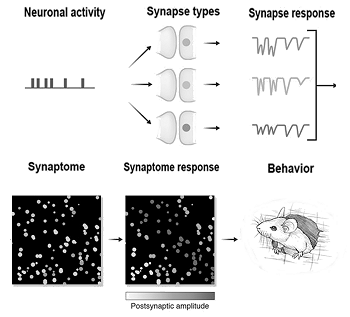 A remarkable paper from a team at Edinburgh explains how every synapse in a mouse brain was mapped recently, a really amazing achievement. The resulting maps are available here.
A remarkable paper from a team at Edinburgh explains how every synapse in a mouse brain was mapped recently, a really amazing achievement. The resulting maps are available here.
We must try not to get too excited; we’ve been reminded recently that mouse brains ain’t human brains; and we must always remember that although we’ve known all about the (outstandingly simple) neural structure of the flatworm Caenorhabditis elegans for years, we still don’t know quite how it produces the flatworm’s behaviour, and cannot make simulations work. We haven’t cracked the brain yet.
In fact, though, the elucidation of the mouse ‘synaptome’ seems to offer some tantalising clues about the way brains work, in a way that suggests this is more like the beginning of something big than the end. A key point is the identification of some 37 different types of synapse. Particular types seem to become active in particular cognitive tasks; different regions have different characteristic mixes of the types of synapse, and it appears that regions usually associated with ‘higher’ cognitive functions, such as the neocortex and the hippocampus, have the most diverse sets of synapse types. Not only that; mapping the different synapse types reveals new boundaries and structures, especially within the neocortex and hippocampus, where the paper says ‘their synaptome maps revealed a plethora of previously unknown zones, boundaries, and gradients’.
What does it all mean? Hard to say as yet, but it surely suggests that knowledge of the pattern of connections between neurons isn’t enough. Indeed, it could well be that our relative ignorance of synaptic diversity and what goes on at that level is one of the main reasons we’re still puzzled by Caenorhabditis. Watch this space.
The number of neurons in the human brain, curiously enough, is more or less the same as the number of stars in a galaxy (this is broad brush stuff). In another part of the forest, Vazza and Felletti have found evidence that the structural similarities between brains and galaxies go much further than that. Quite why this should be so is mysterious, and it might or might not mean something; nobody is suggesting that galaxies are conscious (so far as I know).
